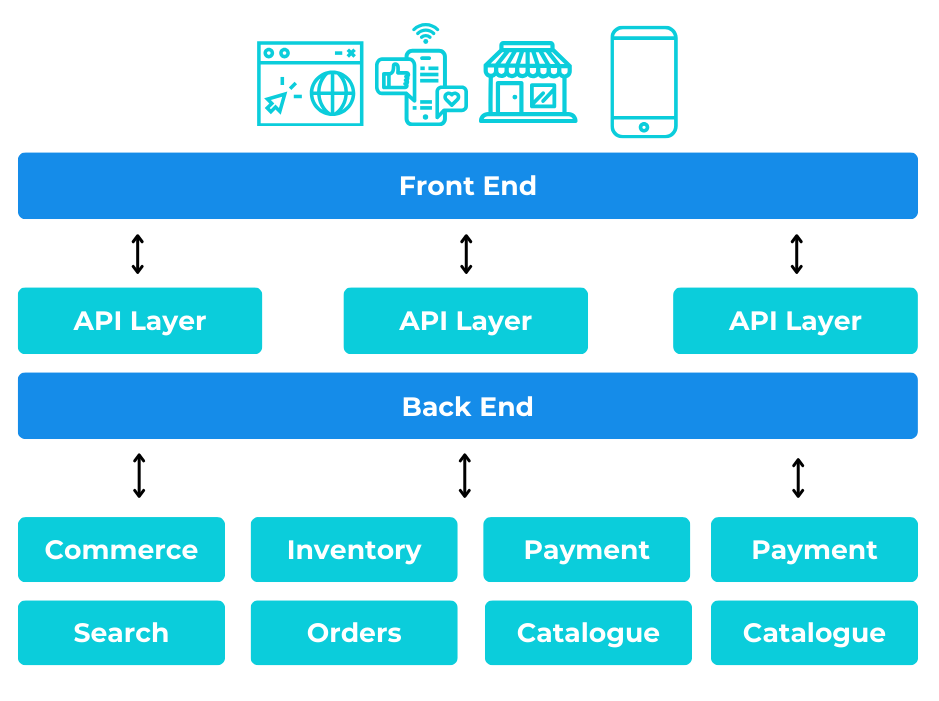For ecommerce businesses looking to enhance their customer experience, keeping up with trends is crucial. By understanding and implementing these trends, you can improve customer interactions, differentiate your brand, and drive sustainable growth. This article covers three key CX trends: values-driven strategies, composable commerce, and omnichannel solutions.
Trend 1: Composable Commerce and Building for Adaptability
Composable commerce involves building ecommerce platforms using modular components. This allows for a highly customisable model by integrating the best available technologies for specific functionalities rather than relying on a one-size-fits-all system. The adaptability of composable commerce ensures that your ecommerce business can adapt to changing market conditions and customer expectations.

How can this trend increase your ecommerce sales?
- Enhanced Customer Experience: An adaptable ecommerce business can better meet customer needs by providing timely and relevant solutions, improving customer satisfaction and loyalty.
- Competitive Advantage: Ecommerce businesses that adopt the composable commerce approach gain a competitive edge by being able to innovate and adjust faster than their competitors.
- Opportunities for Creativity and Brand Differentiation: Composable commerce allows ecommerce businesses to be very creative, enabling your brand to have immersive shopping experiences.
Evolving with Composable Commerce
At e2y, we believe in a balanced approach to ecommerce success. While we work in composable commerce, we recognise that it’s crucial to assess which key elements of your business are best handled by a core platform and where more flexible, best-in-class composable elements can provide added value. With our expertise, we build a tailored solution that not only adapts to your evolving needs but also ensures a scalable and robust platform that drives long-term growth.
Top Brands Implementing This Trend
Ulta Beauty uses composable commerce to integrate digital and physical experiences. This approach helps Ulta handle traffic peaks during promotions and product launches without compromising the user experience. Ulta Beauty’s adaptable platform allows it to meet changing customer preferences and market conditions, maintaining its position in the beauty industry.
Trend 2: Omnichannel and In-Store App Integration
Creating a seamless experience across online and offline channels allows customers to transition easily between them. This approach ensures a cohesive customer journey, whether shopping online, in-store, or both. By integrating omnichannel strategies into your platform, your business can provide a unified, convenient, and personalised shopping experience.

How can this trend increase your ecommerce sales?
- Enhanced Customer Experience: By offering a seamless and personalised experience on all channels, you can improve your ecommerce business’s customer experience and increase customer lifetime value.
- Increased Sales and Loyalty: The convenience and personalisation of an omnichannel approach encourages repeat purchases and fosters loyalty, leading to higher sales.
- Optimised Operations and Marketing: By collecting and analysing customer data across all channels, you can tailor and personalise your marketing and advertising efforts via classic or AI-powered processes.
Practical Strategies for Implementation:
- Mobile Ordering: Enable customers to place orders through a mobile app for in-store pickup, reducing wait times and offering convenience.
- Personalised Offers: Utilise advanced analytics and CRM systems to track and analyse customer interactions.
- Omnichannel Customer Support: Implement a unified support platform that centralises all customer interactions, enabling you to provide high-quality customer service across all channels.
Top Brands Implementing This Trend:
Burberry is known for its effective omnichannel strategies that enhance customer engagement and drive growth. Their approach includes a strong presence on 20 social media platforms, live-streaming fashion shows, and social shopping through Snapchat and WeChat. By integrating digital interactions with physical retail, Burberry has improved customer convenience and ensured a consistent brand experience across all channels
Trend 3: Values and Sustainability
Leading with values is not just a trend; it’s a strategic approach to boost customer loyalty, enhance reputation, and stand out in a competitive market without resorting to price-cutting tactics. Today’s consumers expect brands to contribute positively to society, so a values-driven strategy helps your business stand out and align with the deeper expectations of your audience.
How Can This Trend Boost Your Ecommerce Sales?
- Increased Customer Loyalty: Leading with values helps develop a strong customer base. Customers who align with your brand’s values are more likely to become repeat buyers and advocates for your business.
- Brand Differentiation: In a competitive market, value-driven brands stand out. A genuine commitment to important issues can set your brand apart from competitors who lack a strong values-based approach.
- Enhanced Reputation: A values-driven strategy can boost your brand’s reputation, making it more appealing to customers.
Implementing Your Values-Driven Strategy:
- Value Communication: Showcase your brand values through marketing materials, your website, and customer communications.
- Ethical Practices: Implement ethical business practices such as fair trade sourcing and sustainable packaging.
- Social and Environmental Initiatives: Launch initiatives that reflect your values, such as reducing carbon footprints or supporting charitable causes.
- Internal Engagement: Foster a workplace culture that aligns with your values, encouraging employees to be ambassadors of these values.
Top Brands Implementing This Trend:
IKEA’s commitment to sustainability focuses on economic growth with positive social impact and environmental protection. To address these goals, IKEA focuses on three key areas: Healthy and Sustainable Living, Circular & Climate Positive, and Fair and Equal. They offer eco-friendly home furnishings and food products, extend product lifecycles, and make sustainable living more accessible and affordable.
This values-driven approach reinforces IKEA’s brand as a leader in sustainability, helping to build customer loyalty and differentiate the brand in a crowded market.
Conclusion
Embracing values-driven approaches, adopting composable commerce, and implementing omnichannel strategies are essential for ecommerce businesses aiming to thrive in a competitive market. Implementing these trends will align your ecommerce with evolving consumer expectations and position you for long-term success.
At e2y, our ecommerce expertise and advanced technology implementations can help your business embrace these trends, excel in your market, and achieve remarkable results.
Contact us today to learn how e2y can elevate your business.
Designed by Freepik




